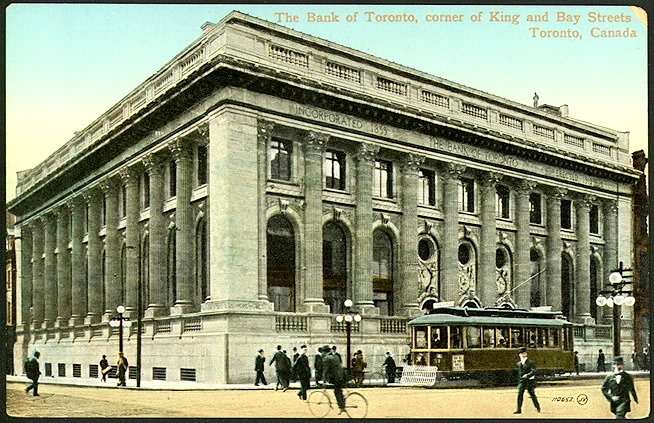
Modeling the Legend, or, the Trouble with Diamond and Dybvig: Part II
 [This is the last half of a two-part critique of Douglas Diamond and Philip Dybvig’s highly influential paper purporting to show that fractional reserve banking systems are inherently unstable. Part I can be found here.]
[This is the last half of a two-part critique of Douglas Diamond and Philip Dybvig’s highly influential paper purporting to show that fractional reserve banking systems are inherently unstable. Part I can be found here.]
Sauce for the Goose…
Half a century after the fact, the “aggregate uncertainty” version of the Diamond-Dybvig model appeared at long last to offer solid proof of the inherent instability of ordinary banks, together with an equally solid foundation for government deposit insurance. But no sooner had the inspectors started poking their flashlights around that supposedly solid structure than its serious weaknesses became evident.
The first casualty of that inspection was Diamond and Dybvig’s case for deposit insurance. That case depends on their model’s “sequential service” constraint, which calls upon their bank to meet its depositors’ demands on a first-come-first-served basis. The constraint matters because, if it could instead delay paying its customers until it has received all of their requests, a Diamond-Dybvig (“D-D”) type bank could make its period-1 payments contingent on total period-1 withdrawals, thereby ruling-out runs despite aggregate uncertainly, by achieving the same structure of expected returns it might achieve using the threat of suspension in the aggregate certainly-sequential service case.
The problem with Diamond and Dybvig’s case for deposit insurance is that it implicitly and illogically exempts government authorities from the sequential service constraint imposed on the D-D bank. In order for the deposit insurance solution to work, the government must itself accumulate all period-1 payment requests, and then present those making such requests with their (optimal) tax bills before they actually withdraw funds, lest unwanted withdrawals should cut into period-2 returns by interrupting the production process. There must, in other words, be no “first-come-first-taxed” constraint on the government corresponding to the bank’s “first-come-first-served” constraint. Although Diamond and Dybvig recognized that their case for deposit insurance rests upon this “asymmetry” in their treatment of the sequential service constraint, they never bothered to justify it. They therefore opened themselves to the charge, leveled at them by Neil Wallace, of not taking their model’s sequential service constraint “seriously.”
That charge in turn suggests two obvious alternatives. One—imposing the sequential service constraint on government and bank alike—would rule out Diamond and Dybvig’s scheme. But the other—exempting government and bank alike—would serve their ends no better, because it would make a private-market, contractual solution feasible despite aggregate uncertainty. As Hu McCulloch and Min-Teh Yu explain, because the “tax” involved in Diamond and Dybvig’s insurance scheme is really just a “redistribution between period 1 withdrawers and nonwithdrawers,” once the Diamond-Dybvig bank is itself freed of the sequential service constraint, it can arrange to contractually implement the same “tax” itself.
As fatal as McCulloch and Yu’s observation is to Diamond and Dybvig’s argument for deposit insurance, in merely suggesting that insurance can do no better than voluntary contracts might, it understates the weakness of that argument, which rests upon Diamond and Dybvig’s assumption of a single, riskless production technology. As Diamond and Dybvig themselves recognize, because it “abstracts from the choice of bank loan portfolio risk,” the assumption of a single, riskless production technology sidesteps the notorious problem of moral hazard.
As Denise Hazlett has shown, allowing a Diamond-Dybvig bank to invest in either riskless or risky assets can easily sway the balance in favor of laissez-faire. Hazlett makes the point neatly by abstracting from aggregate uncertainty. Doing that makes the Diamond-Dybvig insurance scheme feasible even with a generalized sequential service requirement. But as we’ve seen, it also makes suspension of convertibility a first-best solution to the problem of runs. Insurance, on the other hand, isn’t such a good solution, because although it discourages runs, it also encourages excessive risk taking. Although Hazlett shows how certain regulations can limit the moral hazard problem, these also tend to make insurance less effective in discouraging runs.
Capitalists to the Rescue
That Diamond and Dybvig’s argument for deposit insurance isn’t tenable doesn’t itself dispose of their main finding, which is that private arrangements can’t guarantee a first-best banking outcome when there is aggregate uncertainty and withdrawals are granted on a first-come-first-served basis. But this finding depends crucially on several odd features of their “bank.”
One of these odd features is the Diamond-Dybvig bank’s “demand deposit” contract. As Kevin Dowd points out, that contract differs from actual bank deposit contracts in treating patient, type-2 depositors as residual claimants even when they don’t panic. Yet the Diamond-Dybvig bank also doesn’t make use of equity financing as that’s normally understood. Instead, its liabilities are debt-equity “hybrids.” The “bank” itself is therefore something of a cross between a real-world bank and a mutual fund.
This difference between a Diamond-Dybvig bank and an actual bank turns out to be more than a mere technical shortcut. For the substantive question is whether real-world banks, and not just the hybrid and entirely imaginary institutions found in Diamond and Dybvig’s paper and most subsequent studies based on it, are inherently failure-prone; and it turns out that real-world banks, with their reliance upon both debt and equity financing instead of a hybrid of the two, are less likely to exhibit the “bad” equilibrium of Diamond-Dybvig style banking, and might never exhibit it at all.
To see why, it suffices, as Dowd demonstrates elsewhere, to assume that, besides type-1 and type-2 consumers, the world is inhabited by others—let’s call them “capitalists”—who are sufficiently well-endowed to be able to invest K units of capital without the least risk of wishing to consume them at T = 1. Suppose they do so by buying shares in a “bank” that’s otherwise the same as the one modeled by Diamond and Dybvig. Dowd shows that such a bank, with its distinct set of “pure” residual claimants, could prove attractive to capitalists. More importantly, it would certainly be more attractive to depositors than an ordinary D-D bank, because it would make runs both less likely and less harmful to them if they ever occurred.
The possibility of a run on a D-D bank arises, Dowd observes, because type-2 depositors know they might suffer losses if too many other depositors withdraw in period 1. But if K is big enough—specifically, if K ≥ (r1 – 1)[1]—type 2s would have absolutely no reason to fear losses and withdraw early. In short, capitalists can do what neither deposit insurance nor suspension of payments is capable of doing: they can guarantee a “good” equilibrium despite the presence of aggregate uncertainty.
Allowing for Bank-Issued Money
Another peculiarity of Diamond-Dybvig style “banks” is that, unlike real-world banks, they don’t offer payment services. Indeed, as Gary Gorton and Andrew Winton note, there are no distinct means of payment or exchange of any kind in the Diamond-Dybvig model and most variations upon it. In particular, “[t]here is no purchase of consumption goods using bank liabilities as money. In the model, the bank is, in effect, also the store.” In the real world, in contrast,
consumers buy goods with bank liabilities without any need to return to the bank to withdraw. This is the essence of a medium of exchange. And that is how bank notes and bank deposits work. While consumption smoothing, and the demand for consumption insurance, are likely important features of reality, it is not clear that consumption smoothing is really a meaningful sense in which bank liabilities are a medium of exchange.
Here once again, the peculiarity of the Diamond-Dybvig bank isn’t innocuous. It’s only thanks to it that suspension of payments can’t be relied upon to achieve a first-best banking outcome in the face of aggregate uncertainty.
The trouble with suspension in the aggregate-uncertainty version of the Diamond-Dybvig model is that it can frustrate the consumption plans of type-1 consumers: if the bank underestimates t, the bank will suspend payments even when there’s no run, leaving some impatient customers out in the cold: because the bank is their only source of “corn,” they’re forced to go without. “A suspension of payments in the D-D model,” I note elsewhere, “has the same effect that closing all retail outlets for real goods would have in an actual economy.”
In contrast, a real-world bank suspension doesn’t necessarily prevent bank customers from acquiring consumption goods. In reality, goods are sold by separate producers and merchants. Banks, for their part, use savings entrusted with them to finance those merchants and producers, but don’t produce or sell goods themselves. However, their liabilities can be used to purchase goods, and not merely to reclaim deposited funds. They serve, in other words, as means of payment. It follows that, when a real-world bank suspends payments, although it prevents holders of its IOUs from cashing them, it doesn’t necessarily prevent them from going shopping. So long as merchants remain willing to receive suspended bank IOUs at face value in payments, a real-world bank suspension can thwart a run without limiting impatient depositors’ ability to consume their savings.
To illustrate this point, some years ago I constructed an alternative version of the standard D-D model designed to allow a role for a non-bank exchange medium, which I call “gold.” To make gold useful, I assume that the economy’s N consumers have no corn endowment in period 0, but are instead endowed with one ounce of gold each. I then add “corn merchants” to the economy, endowing them with an inventory of at least N bushels of corn, but no gold. Consumers and their bank must purchase corn from corn merchants, who are assumed to sell it at a given “world” price of one gold ounce per bushel. Finally, I assume that corn merchants, like type 2 bank depositors, are “patient” consumers.
I then consider two cases. In the first, a “gold only” payments technology prevails. In the second, “transactable” bank liabilities can serve in place of gold. I then show that, in the gold only case, all the results of the original D-D model are replicated, including the finding that, with aggregate uncertainty, suspension can harm type-1 consumers. The difference is that this result is due, not to “the fact that all ‘goods’ are locked-away in bank vaults,” but to the fact that type 1 agents can’t trade their bank deposit credits directly for available corn. The difference, I note, makes my version “more consistent with the ‘stylized facts’ of historical banking crises, which typically have involved shortages of money but not shortages of consumption goods.” The national bank “holiday” of 1933 was a notorious instance of this.
The second case I consider differs from the first only in allowing bank deposits to be directly traded for corn. Impatient consumers can then offer to exchange their bank deposits directly for merchants’ corn, with the merchants then joining ranks with other type-2 depositors. I show that this modified model also replicates the results of Diamond and Dybvig’s original, but with one crucial difference: suspension no longer harms type-1 consumers, who can go on trading their deposits for corn just as they might if suspension weren’t resorted to. Merchants’ own “patience” suffices to guarantee this outcome, because it makes them as willing as type-2 depositors are to hold suspended bank deposits, so that they have no reason to refuse payments that take the form of such deposits.
While the consequences of the 1933 bank holiday resemble those of suspension in the “gold only” version of my modified D-D model, earlier payment “restrictions” overseen by private bank clearinghouses came closer to the benign suspension of the version with transactable bank money. This was so because the private clearinghouses and their member banks continued to process checks, and also because banks and clearinghouses both issued low-powered paper substitutes for gold and high-powered paper money. During the 1933 holiday, in contrast, banks were closed altogether, and clearinghouses were prevented from issuing “emergency” currency. It appears, in other words, that, instead of illustrating the inherent shortcomings of suspension in the presence of aggregate uncertainty, the harm done by the bank holiday instead illustrates the potential disadvantages of a government-mandated suspension of payments compared to the sort of suspensions that are likely to be resorted to on a voluntary basis.
An Untestable Theory
That the predictions of the Diamond-Dybvig model should seem most consistent with what happened in the U.S. in late February and early March, 1933, than what transpired elsewhere during that decade, or in the U.S. at other times, is no surprise. As I noted at the onset, Diamond and Dybvig almost certainly drew inspiration from that singular U.S. episode.
It doesn’t follow, however, that D-D model’s implications are inconsistent with other episodes, including those of Scotland, Canada, and other nations where for significant periods the lack of either deposit insurance or a lender of last resort went hand-in-hand with an almost equally complete lack of bank runs and panics. This is so for the simple reason that the D-D model is empirically vacuous: according to it, panics are random events. Indeed, as Andrew Postlewaite and Xavier Vives have pointed out, they have got to be random events, for no one would put money (or “corn”) in a D-D bank knowing that a panic was due.
It follows that, although panics are possible, they need never occur. The difference between the U.S. and, say, Canadian banking experience during the 1930s therefore poses no problem: Canada just happened to get lucky. (So, apparently, did Czechoslovakia, Denmark, Lithuania, the Netherlands, and Sweden, among other places.) “Luck,” or its absence, accounts for differing outcomes that might otherwise have to be traced to differences in macroeconomic conditions, the industrial organization of banking, bank investment fundamentals, prudential and other regulations, and a host of other potentially-relevant factors. And since but one cause, bad luck, is to blame for panics everywhere, the same solution or small set of solutions—deposit insurance or an alert last-resort lender or narrow banking—are the only conceivable remedies to any actual or potential banking crisis.
Because it’s consistent with any observed pattern of runs and panics, the D-D theory of banking instability is untestable and, therefore, unfalsifiable. This might sound like a good thing. But it isn’t. For one thing, it makes the theory incapable of accounting for “the stylized facts” of banking history. As Gorton and Wintrop point out, anyone conversant with those facts will find it “straightforward to observe that banks are not fundamentally flawed institutions. …Panics simply are not a feature of most economies that have banks. The world is more complicated.”
In other words, factors other than sheer “luck” appear to matter. As we’ll see, one of those factors consists of laws that limit banks’ freedom to manage their affairs as they see fit.
A Not So Holy Grail
Practically all of the models that build upon Diamond and Dybvig’s pioneering effort retain that effort’s mechanism-design framework, with its peculiar assumption that, whatever else it does, a good bank model has to be able to show that banks and banking systems are inherently vulnerable to runs. “Some researchers believe,” Gorton and Winton observe (with Diamond and Dybvig and their adherents in mind), “that a theoretical model of the existence of financial intermediaries must simultaneously be a model of panics; banks and panics are inherently intertwined and models should reflect this.”
For many economists, in other words, the “inherent instability” claim is not just one hypothesis among many to be explored and tested, but an axiom no theory worth taking seriously can contradict. The unshakeable aim of the “substantial economic literature” launched by Diamond and Dybvig’s paper, Huberto Ennis and Todd Keister observe, has been “to identify the essential components” of a laissez-faire banking system that would justify the opinion “that banks…are inherently fragile, in the sense of being susceptible to a self-fulfilling run by their depositors.” More bluntly: a plausible theory of banking consistent with the idée fixe that banks are inherently unstable has long been the Holy Grail of economists studying the subject.
In his excellent survey of post Diamond and Dybvig research up to 2010, Ricardo Cavalcanti also acknowledges this Holy Grail approach. Noting that the models he covers “seem so distant from monetary theory,” he says this was unavoidable, for other approaches would have yielded “controversial…conclusions about fragility.” That is, they were bound to be even less capable of demonstrating banks’ inherent instability than ones that followed Diamond and Dybvig’s “mechanism design” approach in which the modeler starts by treating a bank run as one of several objectives his or her bank must accomplish, and works backward from there. Economists, Calvalcanti says, had
to give serious consideration to the possibility that financial fragility is an intrinsic consequence of trying to extend to individuals the best liquidity arrangements possible. This favors mechanism design over general equilibrium theory.
Indeed it does. But after yet another decade of toying with such models, with ever-diminishing returns, might it be that they’ve received as much serious consideration as they deserve? Might it be time to consider the possibility that, in seeking the causes of banking crises in the very nature of banking itself, economists have been barking up the wrong tree? Might an alternative approach prove more fruitful?
One such alternative turns the Diamond-Dybvig strategy on its head, by starting with the assumption that an unregulated bank is a robust institution, and then asking what sort of regulatory interventions can make it less so. Among other insights that can be gleaned from it, the Diamond-Dybvig literature shows that modeling a robust banking system, meaning one with contracts that rule-out “bad,” panic-based equilibrium, is relatively easy. So why not start with such a model—the more realistic the better—and then consider whether, and how, various regulatory restrictions can undermine the good equilibrium, either by ruling it out altogether or by introducing an alternative, “bad” equilibrium? In fact, there’s no need to start such an alternative research program. It has already been started, for at least some of the “bad” outcomes in extant Diamond-Dybvig models are readily interpreted as consequences, not of laissez faire, but of unnecessary legal restrictions
Whereas empirical (as opposed to mythical) support for the “inherent instability” hypothesis is scarce, there’s no shortage of evidence favoring this alternative “legal restrictions” theory of banking crises. For starters, there’s the fact that some of the world’s least heavily-regulated banking systems have also been remarkably crises free. There is the fact that voluntary contracts allowing bankers to suspend convertibility of their liabilities—the most obvious private-market device for preventing runs—have frequently been outlawed. Finally, there are piles of evidence concerning the (often crucial) role other misconceived regulations have played in past banking crises—so much evidence, indeed, that it’s hard to discover any past banking calamity in which misguided regulations played no part. Besides the works just linked, skeptical readers are encouraged to consult Fragile by Design, Charles Calomiris and Stephen Haber’s excellent 2014 survey which, thick though it is, is but the tip of a very large iceberg.
***
In his essay, “Monetary Theory and History: An Attempt at Perspective,” Sir John Hicks observed that “Monetary theory is less abstract than most economic theory; it cannot avoid a relation to reality, which in other economic theory is sometimes missing. It belongs to monetary history, in a way that economic theory does not always belong to economic history.”
What Sir John said of monetary theory necessarily goes for its subdisciplines. It follows that the theory of banking also “belongs” to monetary history, and therefore can’t avoid a relation to reality. The trouble with Diamond and Dybvig’s model is that its relation to reality is so very distant that the two might as well be perfect strangers.
_______________
[1] This condition, Dowd notes, “is a sufficient condition to rule out runs, but it is not a necessary one… While depositors would obviously prefer as much reassurance as possible, other things being equal, a higher capital base means a lower return on bank equity, other things again equal, and a lower return on bank equity makes the equity itself harder to attract. …[T]he optimal level of capital will trade off the reassurance it provides the depositors with the cost of the capital itself.”
The post Modeling the Legend, or, the Trouble with Diamond and Dybvig: Part II appeared first on Alt-M.



